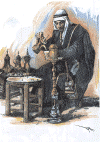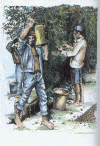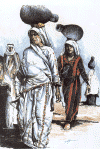Palestinian Heritage
Through
Pictures..1
Through Pictures..2
Through Pictures..3
Through Pictures..4
Palestinian History
Selected
Paints 1
Selected Paints 2
Ismail
Ashour selects the lexicon of his word from a memory furnished with the vigour of life. You
can but close your eyes and open them to his painting for a vast space to open with them that
spreads like the reading book, for the village to wake up and for the fields to gather the
harvesters. The little town twirls with, innocence totally immersed in it, so that you can
almost hear the noise of the people and childrenís play and inhale the tender dew laden air
of Palestine. He is a guard, this able loving painter .He neglects not the slightest twitch or
the tiniest gesture that colour this memory . Nevertheless, he is not a tourist or the tiniest
guide pointing with tenderness, with pity and embarrassment from the distance to the wrinkles
of the land . But he is weed and stone, every spring and basketmaker, and every home loom and
home. As if all this not suffcicient, he establishes connections between the palestinian
folkloric life and its components. Thus the mute paper becomes the whole of Palestine. You
need only look closely in order to enter into it and become part with its people. Ismail
Ashour neglects not, with his prompt and precise captions, to furnish your memory with the
peopleís inherited speech, their proverbs abd saying spun in the looms of their continued
life . You are invited to Palestine, and you stand among these simple people an owner of a
home. You ponder upon this land resurrected by Ismail , dressed with colour and furnished with
memory, you see that man is in the center of light, either a craftsman or another of some
relation . And for a certain intention, he revolves around a particular generation . All his
characters appear to be in their forties, except for a few he brought in to complement the
scene. Perhaps this is not a coincidence; traditionally, the bread winner in the Palestinian
family is the father. The artist who borrows the eyes of his childhood to gather the pieces of
his world can only see his father the same as a child. As
you move along, you to notice the similarity and familiarity of the faces, setting a dramatic
line connecting humanbeings. These are not faces of trendy modeles posing in traditional
graments, but faces whoes features are shaped
from the earth of the village, scortched by its sun pulsating with its tradition . They are
all kins, or seem to be, so that with a little imagination you tend to inquire of one of them
about the dwellings of another . Then, a boy from an another drawing would takes you by the
hand to guide you to your destination. Let
me reveal a secret . The artist did his drawings in black and white. Then he convinced by a
friendís advice, he applied his colours Just like the old photographer (who is also
portrayed there ) he roams the old quarters, and puts his timid touches for his characters to
get their dress in all its colours and wrinkles and shadows, as if on a day of the feast, it
is so becoming to wear new clothes on the day of the feast. This
innocent episode to the nature of the residence place in the artistís
mind.
They
are ever preset, because he is one of them and a son of theirs.If




